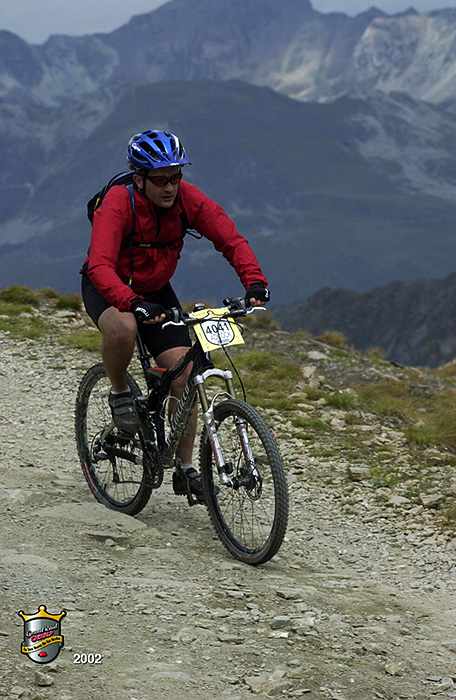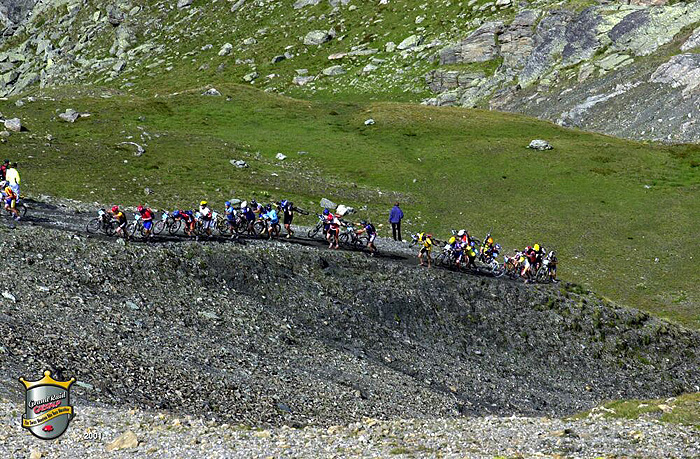We are perhaps foolish but not fools, so Jens and I opted for the short run, where we were joined by Nicolai for the 6:30 start in Heremence. It should be noted that this half-marathon is really two-thirds, and incorporates all the 'tough' riding of the full version. It is not to be sneezed at. Meanwhile, in his foolishness, Simon lined up in Verbier for the full distance: it seems he has forgotten the pain he suffered last year. After the gun sounded in Heremence at 6:30, the three of us eased our way over the start line, wished each other good luck and began the first climb of the day. This was the 22km, 1010m climb to Mandelon which snaked up the valley on progressively deteriorating asphalt and then gravel roads. Despite the ungodly starting hour, it was very warm, and my wind cheater and arm warmers were immediately stowed away.
During the first half hour, I felt pretty uncomfortable, and in particular I seemed to have pretty strong stomach aches which I dismissed as caused by a large breakfast, the early start and perhaps some pre-race nerves. Anyway, as we climbing higher, I settled into a rhythm a few hundred meters behind Jens and a few hundred ahead of Nicolai: we waved at each other periodically from overlooking hairpins. At the first feeding stop, the route moved off the marked roads and onto single trails: as we crested the Mandelon climb, the route swung through the Paturages de Mandelon, or literally, Mandelon's pastures. This was a rideable but technical single trail, snaking around the hillside and constantly dipping up and down, left and right. This was the first of several bottlenecks: the first person who couldn't ride a section dismounted, and so blocked the route for all those behind him or her. We quickly realised the logical outcome of this, and all dismounted to walk the next 5kms or so. I say quickly but this was not an immediate result: I watched one guy all of his bike at least 6 times in about ten minutes before he gave up. In fact, it was a bit like the biking version of the Demolition Derby with people falling off left and right at regular minute intervals.
Mandelon leads to the village of Evolene, via a 1000m downhill. Most of this was on fast but bumpy gravel roads, before the last section where the route dipped off the roads and onto the single tracks again. I thought the downhills were magic, technically demanding but rideable, but by the number of people dismounting (both planned and unplanned), many did not agree. I did spot a few people with obviously broken collar bones, so I guess they had a right to grumble.

Another feedstop at Evolene led to the climb to Eison, a short but sharp 440m climb, mainly on gravel roads. At the top of the initial climb, the route again turned off the roads into fields, and headed across country. Although marked on the route map as a downhill, it felt to me to be more or less even, first dipping down followed by a short uphill. Again, this lead to bottlenecks, with the crap downhillers blocking the route, only for the good downhillers to dismount on the uphill section. Eventually, everyone realised that you could walk as quick as the ride-dismount-ride combination, so another human chain was built. I put my frustrations aside and used the rest to feed up properly for the final climb, up to the Pas de Lona.
The Pas de Lona climb starts on gravel roads at Eison, and climbs 1200m first hitting La Veille which is the final timecheck point. At this point, I was starting to tire, but more worrying were the stomach cramps which had returned with a vengeance. I ploughed on upwards, counting off the altitude on my bike computer thinking "I wonder if the next feedstop has a toilet?". After about an hour, I had reached an altitude of 2200m but no feeding station, and I realised that I either had to make an allowance for these stomach problems or was about to have a soggy accident. Anyone can tell you though, that 2200m is well above the tree-line in the Alps, and this particular section was also totally featureless. After ten minutes of searching and praying, an accident was nigh so I parked up my bike and dove behind the only cover I could find - best described as a small shrubbery. As I relieved myself, dozens of riders rode by just below me on the road - I couldn't help thinking of the Monty Python sketch with the goldfish - you know: "Mornin'... mornin'... hello... Good Morning". Almost no-one noticed me despite the exposed position - Unfortunately the one person who briefly but definitely swapped eye contact was a female competitor. I'm not sure who more embarrassed. Another feature at 2200m of altitude is the lack of other small plants, in particularly the broad leaf varieties. In fact, the only plants around were myrtile bushes, an alpine blueberry which grows on a spiky bush. Although it probably wouldn't have done my bum any worse damage, the bristly leaves would have had no cleansing effect at all. So, with what I consider to be exceptional resourcefulness, I whipped out my arm warmers for the task, which I have to admit were particularly soft and absorbent (all other bikers take note). To the disgust of my fellow competitors, I did not throw them away but wrapped the soiled arm-warmer carefully in the other and stowed it away. This story was told to much better effect on the day at the finish when I could proudly use these props with the final one liner: "and guess what I used to wipe my arse with... Tada!"
Anyway, it is
amazing how such events can galvanise the spirit. I rode the last few hundred
meters to La Vielle several kilos lighter and like a man with a
new lease of life. La Vielle is the last check point on the route
- it is also the last point you could man a checkpoint as the road ends
here. However, the Pas de Lona is another 400 vertical meters above
you, separated by a walking trail which switchbacks up the mountainside.
After a quick refill at the feedstop (I had made plenty of room, remember),
I started the walk to the summit. This began as a normal hiking trail but
soon degenerates into an incredibly steep, shaley climb. After half an
hour of this, my arms had died, my calves were on fire, my lungs were gasping
and I was still a long way from the summit at 2800m. I remember thinking
that I was used to having nothing left in the legs, but that I'd never
knackered my arms biking before. I also thought "it can't get any steeper
than this", when it did. By this point, the ground had changed into a kind
of 2" deep black ash, without any rocks on which you could get proper purchase.
It is like I imagine the surface of the moon to be. For some inexplicable
reason I found myself singing "Sur le Pont d'Avignon" - I think I was feeling
the effect of the sun or perhaps the altitude. 
After an hour of calf-sapping climbing, I crested the top of the Pas de Lona and another feeding stop after 5 hours and 20 minutes of riding. Ahead of me was the final 1200m descent into Grimentz, separated only by a small climb to the Basset de Lona. I rode 150m down a very steep, technical downhill to the lake at Lona, and then joined a gravel road which climbed up to the Basset. By this point, I was really feeling the effects of the days riding, but apart from one short section managed to stay on the bike and riding. Just below the summit, several spectators began pushing the girl who was riding ahead of me, but looked away when I tried too lock their eyes with my pleading, bloodshot ones. Bloody sexists! As I crested the Basset de Lona, a motor-cross bike came roaring by, warning of the arrival of the leaders of the long race. They had left at roughly the same time as we had, but in the meantime had managed to fit in an extra 55 kilometres. I dipped onto the downhill, a fast but bumpy gravel road, trying to gain a lead on them. After about 2kms, the two riders had got close enough, so I pulled over and let them pass, and then spent the next ten minutes seeing if I could keep up with the best when it comes to downhilling. Although they were pulling away slightly, they were motivated by several thousand francs of prize money, so I was happy with my performance: Hopefully, I'll also be on the official video, chasing the leader down the final downhill. Now all I have to do is find out how to climb the hills at roughly twice my current speed, and then maybe I'll be vaguely competitive.
Simon had complained last year of a "twisty, turny, bumpy, rocky, slippery, slidey, bone braking, brain pulverizing, stream crossing, complete bastard to navigate, steep downhill trail" at the finish. Although a little rough, it no where near met that description. So, as I dropped down to the dam and approached the first bit of asphalt, I was beginning to wonder what was wrong with Simon, and if his parents wouldn't better have named him Simone. But, the route followed the asphalt for about 30m before turning of the side of the road. Then the track descended on a rocky switchback down to the stream below the dam, over which it then criss-crossed back and forth. After the stream-bed, and cries of support from Petra and Alexandra, the route dived down into another steep, very rocky switchback which reminded me of some of our tests in Garda. I remember thinking "God, I wish I had a fully with disc brakes" and "now I know why the organisers insist on the bike technical inspection". As my wrist were beginning to seize and my fingers were starting to cramp from the effort of breaking, we emerged into the last section, a very steep, rocky gravel road into the finish. My hands just held on to the finish.
It took me 6 hours 34 minutes (clocked riding time of 6 hrs 17), which gave me 846th position from about 1900, or 240th from 526 in my age category. Jens had finished 6 minutes earlier. Nicolai, in his first mountain bike race of any description, finished in a very commendable time about an hour later (Nic bust his thumb earlier this summer, so he had had six weeks inactivity and couldn't downhill properly). The winner had completed the course in 4 hours 3', and the first woman came home after exactly 5 hours. Simon, meanwhile, was still out on the course, but eventually finished the whole shattering 131kms in 11 1/2 hours, long after the rest of the MadMilers had headed home. The winner of the long race took 6 hours 17', the first woman 8 1/2 hours. As always, the organisation was flawless with ample feedstops, technical assistance, first aid and spectator support all around the course. In particular, the had a great bike cleaning contraption at the finish which showered down and totally cleaned your bike in seconds. The route itself is physically and technically demanding, and shouldn't be attempted without proper training. It also rides through some of the most amazing scenery in the Alps. Who knows, maybe next year we'll be there for the full version.